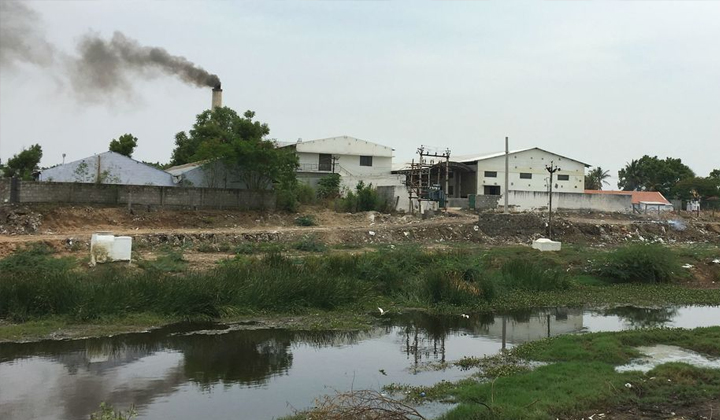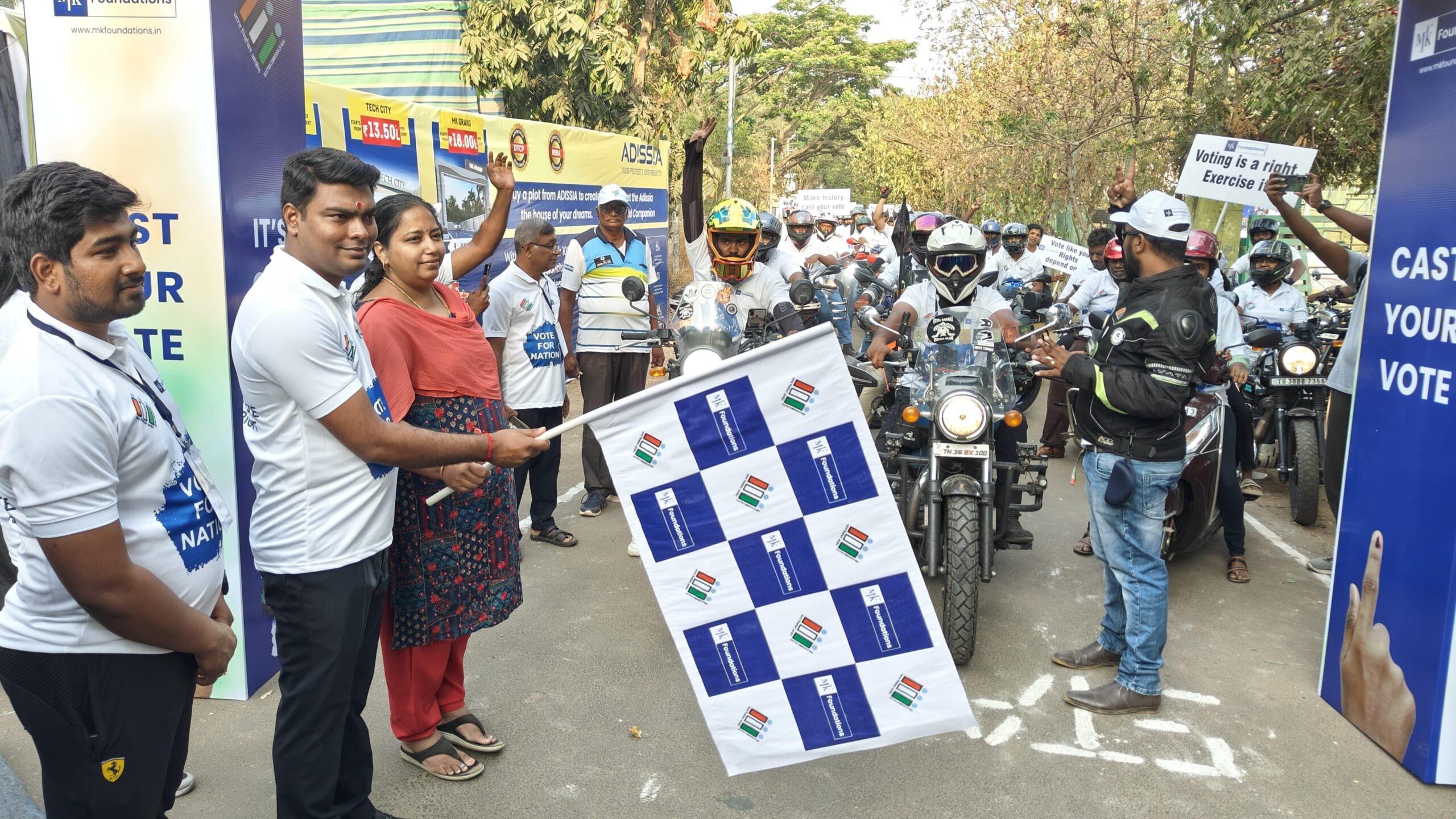Trending Now
- IPL 2024 begins with a bang. First contest between CSK and RCB.
- Election commission allots mike symbol to Naam Thamizhar Katchi
- AIADMK promises to urge for AIIMS in Coimbatore, in its election manifesto.
- Ponmudi becomes higher education minister.
Columns
Can the courts save India’s rivers from pollution? Tirupur shows the answer is no
![]() August 30, 2016
August 30, 2016
The second part of a series from Tamil Nadu tracing the course of Noyyal, a tributary of the Cauvery.
A slum sprawled on one side of the river. In the distance, a factory belched smoke in the air. The riverbed was overrun with weeds and crammed with plastic bags that were half buried into the earth. An earthmover scooped gunk from an open drain and dumped it on top of the debris. The river itself was a thin trickle of black.
Welcome to Tirupur, an industrial city in central Tamil Nadu, where India’s judicial system tried – and failed – to save a river.
The Noyyal is a small river which starts in the western ghats and flows 170 kilometres to merge into the Cauvery. It passes through Tirupur, where factories have been emptying out effluents in its waters ever since a textile hub came up in the 1970s.
After the state failed to protect the river, in 1996, the Supreme Court intervened. It ordered dyeing units in Tirupur to shut down if they could not stop polluting the river. Fifteen years later, in 2011, the Madras High Court followed up by applying the “Polluter Pays” principle, directing the dyeing factories to become zero discharge units by recycling waste water and pumping it back for reuse.
Since then, the larger units in Tirupur have set up their own effluent treatment plants. The smaller ones have come together to set up Common Effluent Treatment Plants. In all, 18 CETPs are operating here.
But the river still does not look clean.
The first part of this series flagged how the state administration in Tamil Nadu has been unable to protect the Noyyal. That story traced the river’s journey from its source till Coimbatore.
This story looks at what happens to the Noyyal after it leaves Comibatore, and why even judicial remedies to protect the river have failed.
The view from Tirupur
The centrality of garments in Tirupur shows up in a million different ways.
Walk down its residential colonies and you will see tiny factories with people sewing or stitching away. A restaurant in a city hotel is called “T-Shirt”, and its outdoor section, “Wind-cheater”.
For the most part, the cluster is small-scale. S Sakthivel, the executive secretary of the Tirupur Exporters Association puts the number of small and medium units in the city to about 7,000.
At the end of a dirt track that parallels the river bank, stand a few dyeing units. The first has a large shed where bales of cream-coloured fabric are being fed into a long machine. The fabric passes through and comes out from the other end a beautiful indigo.
The owner of the company, who spoke on the condition of not being identified, said the CETP is too costly. He pays anywhere between Rs 12 lakh-Rs 15 lakh each month for effluent treatment. This is a problem because his company’s turnover is Rs 12 crore. In an industry as cut-throat as garment export, the Rs 1.4 crore-Rs 1.8 crore that he puts aside for water treatment wipes out most of his margins.
Later in the day, at the CETP at Rayapuram which services this dyeing unit, it becomes clearer why treatment costs are so high. Initially, said a manager at the plant, 31 companies used to get their waste water treated here. Now, only 14 companies do. Seventeen have shut down. This means the running cost of the plant is now spread over a smaller number of dyeing units.
As it is, when units in a cluster are told to get their effluent treated, they cannot compete with those polluting freely. The owner had said: “In Gujarat, they dump raw effluent into the river. Right now, we have a gross margin of about 15%. If we were in Gujarat, that would be 30%.”
This has resulted in some predictable outcomes. Some units, said S Senthilanthan, an academic in Tirupur who has been studying the Noyyal, resettled outside Tirupur and kept polluting as before. The ones that stayed found the costs of using the CETPs kept rising. This created an incentive to try and bypass the CETP and dump waste directly into the Noyyal.
That is not all. After cleaning the waste water by passing it through multiple membranes, the CETPs are eventually left with a slurry. In the early days after the High Court order, there was no disposal system for this reject. A 2014 report by Bangalore-based Ashoka Trust For Research in Ecology and the Environment (commonly known as “Atree”) said: “The reject from all the CETPs was simply being dumped locally… In effect, the entire pollutant load was being released back into the Noyyal in 2009, and the expensive CETP performed no real pollution-reduction function at all.”
It adds: “To what extent this issue has been rectified today is unclear. During our field visits, we found sites where the sludge was being dewatered and dumped in various places…. It appears that the government has not sanctioned an official dumping site. Our field visits and conversations with farmers suggest that dumping effluents into abandoned borewells might be an approach that some industries are adopting.”
Agrees Senthilanathan: “There is no clear protocol on what to do with the slurry. Some of it goes to solar evaporation ponds. But when it rains, they might overflow. There is also the risk of seepage and groundwater contamination.”
As it is, dyeing units are not the only source of pollution in Tirupur. Washing and printing units also release waste water, a businessman pointed out. In addition, effluent is also released by households, eateries and other businesses like automobile workshops. Not to mention unauthorised dyeing units which operate on a very small scale. These work out of residential areas and discharge their wastewater into the local drains. Their waste, said the businessman, flows straight into the river.
Why, then, did the High Court direct only the dyeing units to set up CETPs?
According to D Nagasaila, a lawyer in the Madras High Court who fought the Tirupur case on behalf of the farmers living downstream, the case shows the limitations. “In their petition, the farmers had only mentioned the dyeing industry,” she said. Working with their understanding of the problem, that is how they had defined the source of pollution. And the judges, working with just the information given to them, had cracked down only on the dyeing units.
It makes you wonder if the government should have set up the CETPs instead of putting the onus on individual units.
The consequences of such decisions are visible at Orathupalayam.
Commissioned in 1992, this is one of the most polluted reservoirs in India. For years together, its floodgates were not opened – given farmers’ fears about pollution.
In August 2005 , taking the advantage of heavy rains, the floodgates were opened to flush the reservoir. The exercise deposited over 0.5 million cubic feet of toxic effluents in the Cauvery and yielded more than 400 tonnes of dead fish and a reservoir bed that was several metres thick with toxic sludge.
Six years later, the High Court passed an order imposing the zero liquid discharge rule – essentially telling the dyeing units to reduce their wastewater discharge down to zero.
But, as we see, zero discharge is not quite working. And so, how is the dam doing?
At a tea shop about two kilometres from the dam, villagers say their groundwater is salty and dark in colour. They do not drink it. There is no farming for five kilometres on either side of the river. People in the village – farmers once upon a time – now do job work in Tirupur.
A dirt track takes us towards the dam. Walk up its wall and you gaze down on a reservoir where nothing grows but the scrub tree of Prosopis juliflora. Look downstream and you see black water oozing out of the floodgates. A white foam floats on it.
It is a far cry from the stream that existed 130 km ago – one with water pure enough to drink.
From here, the ravaged river flows on for another 40 km before dissolving into the Cauvery.
If the Noyyal is affected by over-extraction of water and industrial pollution, other rivers in the state are struggling due to sand mining. Later in this series, a look at why sand mining is so rampant in Tamil Nadu.






















